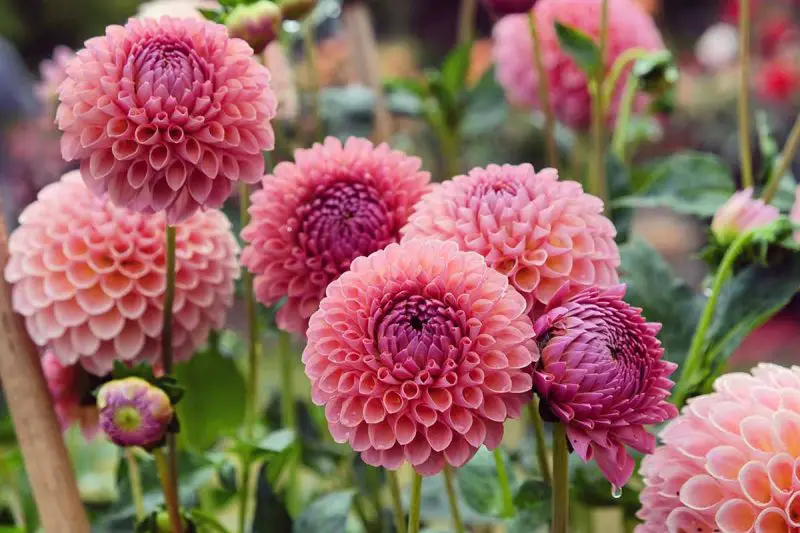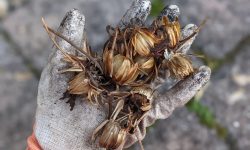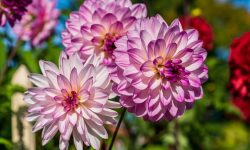Dahlias are among the most stunning flowers you can grow. Their bright colors and layered petals bring life to any garden or indoor space. Each bloom is full of texture and shape, creating a display that feels both elegant and wild. Gardeners adore them for their variety. Some are small and rounded, while others grow into giant, dinner-plate flowers that command attention. These blooms appear in nearly every color imaginable, except true blue, and each type offers something unique.
Many gardeners often wonder, when do dahlias bloom? The answer depends on when you plant, how you care for them, and the climate around you. Dahlias have a clear rhythm that follows the seasons. With the right care, they bloom continuously from midsummer until the first frost. Understanding their growth and flowering stages helps you plan your garden for maximum color. Once you learn their cycle, you can enjoy a long, radiant show of flowers that fill your home and garden with beauty for months.
Understanding the Dahlia Bloom Cycle

Dahlias follow a fascinating and predictable bloom cycle that depends on warmth, sunlight, and consistent care. These plants begin life as tubers filled with nutrients and stored energy from the previous growing season. Once the soil temperature rises above 60°F (15°C), the tubers awaken and start sending out shoots. This early growth phase is crucial, as the plant focuses on building sturdy stems and lush foliage before any buds appear. During this time, dahlias rely on warm soil, moderate moisture, and plenty of sunlight to grow strong enough to support future blooms. From planting to the first flower, most dahlias need between eight and ten weeks, though some varieties may take slightly longer.
As the plant matures, its energy shifts from leaf development to bud formation. Long days with at least six hours of direct sunlight encourage dahlias to produce flower buds continuously. Once buds emerge, they take about two weeks to open fully. Each bloom lasts several days, with new buds forming as old ones fade. The blooming period can stretch from mid-summer until the first frost, depending on local conditions. Regular deadheading, which removes spent flowers, signals the plant to keep producing more blooms. Watering deeply and feeding every few weeks with a balanced fertilizer ensures a steady supply of energy for ongoing flowering.
Late summer and early autumn mark the height of the dahlia’s bloom cycle. Cooler nights and stable daytime temperatures enhance the depth and richness of petal colors, making the flowers more striking. When temperatures fall below 50°F (10°C), the plant begins to slow its growth and store energy back into the tubers for the next season. Understanding this natural rhythm helps gardeners plan when to plant, prune, and harvest for the longest possible blooming period. Dahlias reward this attention with months of vivid, unforgettable beauty.
When Do Dahlias Bloom in Different Climates
Dahlias in Cool and Temperate Climates
In cool and temperate regions, dahlias bloom later in the year but produce some of the most vibrant flowers. Gardeners in these areas typically plant tubers after the last frost, usually in late spring or early summer. Because the soil takes longer to warm up, dahlias may not begin flowering until mid to late July. Once they start, however, the blooms continue steadily through September or even early October, depending on the weather. The cooler night temperatures of these regions intensify the colors of the petals, giving each flower a richer and deeper hue.
Despite the late start, cool-climate dahlias often enjoy a longer display because the mild summer heat prevents premature wilting. Consistent watering and full sunlight are key to sustaining healthy plants. It’s best to avoid overwatering early in the season, as cold soil can cause rot. By midsummer, growth accelerates rapidly, and the plants produce large, showy blooms that stand out against green foliage. In these regions, dahlias become the stars of late-summer gardens, providing a spectacular finale to the growing season.
Dahlias in Warm and Subtropical Climates
In warm or subtropical climates, dahlias bloom earlier and for a more extended period. Gardeners in these regions can plant as early as March or April, once the soil temperature remains consistently above 60°F (15°C). The first flowers typically appear by late May or early June. With long, sunny days and warm nights, dahlias can bloom almost continuously through summer and into late autumn. In some coastal or southern areas, flowering may even persist until early winter if frost does not arrive.
While warmth accelerates growth, excessive heat can stress the plants and shorten the bloom duration. Providing afternoon shade during the hottest months helps prevent wilting and fading. Regular watering is essential, especially in sandy soils that dry out quickly. Adding mulch helps retain soil moisture and stabilize root temperature. With careful attention to hydration and shade, dahlias in warm regions reward gardeners with more frequent and earlier blooms that bring color to the garden long before cooler climates see their first flower.
Dahlias in Tropical and Hot Regions
In tropical climates, dahlias behave differently from those in temperate zones. High humidity and intense heat can make flowering more unpredictable. Instead of planting during the traditional spring season, gardeners in tropical areas often start dahlias in cooler, drier months to avoid excessive heat and rain. When planted between October and December, the first blooms usually appear from January to March. These flowers may be smaller, but the plants grow quickly and vigorously due to year-round warmth.
Because tropical weather promotes fungal issues, ensuring proper airflow and well-drained soil is vital. Dahlias in these regions prefer partial sun rather than full, direct exposure. Too much sun combined with humidity can damage delicate petals and cause stress. Regular pruning and disease monitoring help maintain healthy plants and prolong flowering. Even though tropical dahlias face environmental challenges, they can produce a steady stream of blooms when grown under shaded, controlled conditions. For gardeners in these climates, timing and soil preparation are the secrets to achieving long-lasting, vivid flowers.
Factors That Affect Dahlia Blooming Time
Temperature
Temperature is one of the most significant factors influencing when and how long dahlias bloom. These plants awaken only when soil temperatures reach at least 60°F (15°C), signaling that it is safe for new shoots to emerge. If planted too early, cold soil causes tubers to rot and delays sprouting. Dahlias prefer daytime temperatures between 65°F and 75°F (18°C–24°C) for steady growth and vibrant flowers. In cooler regions, this means planting later in spring, while in warmer zones, dahlias can start earlier but may struggle with extreme heat. Prolonged temperatures above 85°F (29°C) can cause plants to stop blooming temporarily, as they focus on survival instead of producing buds.
To stabilize conditions, gardeners can use mulch to regulate soil temperature and conserve moisture. In colder climates, black plastic or raised beds help warm the soil faster, promoting early growth. In very hot climates, light afternoon shade protects dahlias from heat stress. Consistent, moderate warmth ensures that plants transition smoothly from foliage development to full blooming. Understanding how temperature affects each growth stage helps gardeners time planting and care to achieve strong, continuous flower production throughout the season.
Sunlight
Sunlight is the driving force behind dahlia blooming. These sun-loving plants thrive when they receive at least six to eight hours of direct sunlight daily. Light fuels photosynthesis, which provides the energy dahlias need to grow strong stems and form abundant buds. In shaded areas, plants stretch toward the light, producing weaker stems and fewer blooms. Morning sunlight is ideal because it dries dew quickly and prevents fungal infections, while partial shade in the afternoon helps protect flowers from fading under intense heat. Indoor dahlias benefit from being placed near bright, south-facing windows, and using grow lights ensures consistent illumination during shorter days.
Sunlight also influences photoperiodism — the biological response to day length that triggers blooming. Dahlias begin to flower as days lengthen in early summer, continuing until shorter autumn days signal dormancy. For earlier blooms, gardeners can start dahlias indoors under artificial lights before transplanting them outdoors. Ensuring steady light exposure every day keeps dahlias balanced and productive. When managed properly, sunlight encourages dense foliage, healthy buds, and a stunning, extended display of vibrant flowers across the entire growing season.
Soil Quality
Healthy, well-balanced soil is the foundation for timely dahlia blooms. These plants grow best in nutrient-rich, well-drained soil with a slightly acidic to neutral pH between 6.0 and 7.0. Poor soil delays flowering because the plant struggles to access key nutrients for bud development. Adding compost or aged manure improves soil texture, increases organic matter, and enhances drainage — all essential for healthy roots. Loose, aerated soil warms faster in spring, helping dahlias sprout earlier and bloom sooner. Heavy clay or compacted soil should be amended with sand or perlite to prevent waterlogging and encourage root expansion.
Nutrient balance also plays a major role. Excess nitrogen promotes lush green foliage but suppresses bloom production. Phosphorus and potassium are vital for strong roots and colorful flowers. A balanced fertilizer or organic compost replenished every few weeks keeps the soil fertile. Regular soil testing helps determine pH and nutrient adjustments before planting. Consistent soil health supports long-lasting blooms with intense color and sturdy stems. When the soil is rich and well-tended, dahlias reward you with earlier, larger, and more abundant flowers throughout the growing season.
Watering and Humidity
Consistent moisture is essential for dahlias to bloom on time and maintain their beauty. These plants prefer soil that is evenly moist but never soggy. Overwatering suffocates the roots and causes rot, while underwatering leads to wilting and fewer flowers. Outdoor dahlias should receive deep watering two or three times per week, depending on rainfall and soil drainage. Water early in the morning so that the leaves dry quickly, which helps prevent fungal issues. Indoor dahlias need watering when the top inch of soil feels dry, using pots with good drainage holes to avoid stagnant water.
Humidity levels also influence flower formation and longevity. Dahlias prefer moderate humidity between 40% and 60%. In dry climates, misting the foliage occasionally can reduce stress, while in humid areas, proper air circulation helps prevent mildew. Adding mulch around outdoor plants helps maintain soil moisture and temperature stability. Monitoring watering habits closely ensures balanced hydration, allowing dahlias to produce vibrant, healthy blooms that last longer and stay vivid even during fluctuating weather conditions. Consistent watering and humidity management are key to achieving a prolonged, dazzling display of flowers.
Fertilization and Nutrition
Fertilization plays a vital role in how early and how long dahlias bloom. These heavy feeders require steady nutrients from the time they sprout until the last flower fades. At planting, a low-nitrogen fertilizer such as 5-10-10 supports strong root and tuber development. High nitrogen levels lead to dense foliage but few blooms, delaying flowering. Once buds begin to form, switch to a balanced or phosphorus-rich fertilizer to encourage healthy flower production. Feeding every three to four weeks throughout the growing season provides consistent nourishment that sustains blooming.
Organic options like compost tea, seaweed extract, or fish emulsion are excellent for maintaining natural soil health while delivering essential nutrients. Overfertilizing, however, can burn roots or create salt buildup in the soil, which harms plant health. Always water after feeding to help nutrients absorb properly. Observing your plants is the best guide — slow growth or pale leaves signal nutrient deficiency, while dark, leafy plants without blooms suggest excess nitrogen. Balanced fertilization results in steady growth, bright colors, and continuous blooms that make dahlias a highlight of any garden from summer through fall.
How to Encourage Longer Blooming Periods
Extending the dahlia’s blooming season requires consistent care, proper maintenance, and attention to timing. Dahlias naturally bloom from midsummer until the first frost, but the right techniques can help them produce flowers for several weeks longer. The key is to keep the plant healthy, energized, and free from stress throughout the growing cycle. Start by planting tubers in warm, well-prepared soil and giving them full sunlight for at least six hours a day. Early planting allows the roots to establish before intense summer heat, ensuring a steady supply of buds later on. Once the first blooms appear, consistent watering and balanced feeding keep the flowers coming. Dahlias respond best when soil moisture remains even and nutrients are replenished regularly with a low-nitrogen fertilizer.
Pruning and deadheading are equally important for continuous flowering. Removing faded blooms encourages the plant to produce new buds instead of seeds. Cutting back overgrown stems improves airflow and light exposure, helping prevent disease while promoting new growth. During midseason, lightly trim weaker stems to redirect energy toward stronger shoots that can bear larger flowers. For gardeners in warm climates, providing partial afternoon shade during extreme heat prevents petals from fading too quickly. Indoors, rotating potted dahlias ensures even sunlight distribution and prevents one-sided growth.
As the season progresses, maintaining steady hydration and feeding becomes crucial. Avoid letting the soil dry out completely, as this causes stress that reduces flower production. Mulching around the base of the plant helps retain moisture and stabilize root temperature. In late summer, a dose of potassium-rich fertilizer can extend blooming well into early autumn. Protecting the plant from early frost with garden fabric or moving pots indoors helps preserve the last flush of blooms. With consistent care and attention, your dahlias will reward you with a longer, more colorful display that lasts right up until the season’s end.
Common Problems That Delay Dahlia Blooming
Overwatering and Poor Drainage
Overwatering is one of the main reasons dahlias fail to bloom or develop weak, discolored foliage. These plants need consistent moisture but also require oxygen at the roots to function properly. When soil remains soaked for too long, oxygen levels drop, causing the roots to suffocate and decay. This leads to nutrient deficiency and delays flower formation, no matter how healthy the upper plant appears. Early signs include yellowing leaves, blackened stems near the base, and soft tubers. In such conditions, dahlias divert their energy to survival instead of bud production, which can completely halt blooming for the season.
The best solution is to establish a deep but infrequent watering routine. Allow the top two inches of soil to dry out before watering again. Incorporate materials like compost, perlite, or coarse sand to improve drainage in garden beds. Raised beds or sloped planting areas are also effective in preventing water accumulation. For container-grown dahlias, always use pots with multiple drainage holes and avoid placing trays underneath that trap water. A healthy watering rhythm combined with well-draining soil restores the plant’s balance, helping dahlias bloom on time and continue producing vibrant flowers through the entire growing season.
Lack of Sunlight
Sunlight directly affects the timing, size, and quality of dahlia blooms. When these plants receive less than six hours of sunlight daily, photosynthesis slows, and energy levels drop dramatically. Without adequate light, dahlias focus on stretching toward the nearest light source rather than producing buds. The result is tall, weak stems, pale foliage, and delayed or absent flowering. Shade from fences, trees, or nearby buildings often causes these issues in outdoor gardens. Indoors, insufficient light can also occur when windows face north or are blocked by curtains or surrounding structures.
To correct this, reposition plants where they receive maximum sunlight, preferably full morning and partial afternoon light. Trimming surrounding vegetation that casts shade allows better exposure. For indoor growers, LED grow lights or full-spectrum fluorescent bulbs can effectively simulate daylight, keeping plants vigorous even during shorter winter days. Increasing light not only accelerates bud development but also enhances bloom color and petal strength. Sunlight also helps regulate the plant’s internal rhythm, ensuring dahlias bloom steadily throughout the season with fuller and more radiant flowers.
Nutrient Imbalance
Nutrient imbalance is another factor that delays blooming or reduces flower quality. Dahlias are heavy feeders and require specific nutrients at each growth stage. When nitrogen levels are too high, the plant grows lush green leaves but fails to produce flowers. Conversely, too little phosphorus restricts bud formation, and inadequate potassium results in weak stems and faded blooms. These deficiencies are often caused by poor soil fertility, overfertilization, or using the wrong fertilizer type. Gardeners may mistakenly think frequent feeding helps, but overdoing it often harms root systems and slows blooming.
To correct this, use a fertilizer with a low nitrogen ratio and higher phosphorus and potassium, such as 5-10-10. Apply it every three to four weeks once plants are established and budding begins. Organic gardeners can enrich soil naturally using compost, bone meal, or fish emulsion. Always water after fertilizing to help nutrients absorb properly and prevent salt buildup. Observing leaf color and growth patterns helps detect imbalance early — pale leaves may signal a deficiency, while dark, leafy plants without buds suggest excess nitrogen. With proper nutrition, dahlias bloom faster, last longer, and display richer, more vivid colors.
Pest and Disease Issues
Pests and diseases are frequent culprits behind delayed or reduced blooming in dahlias. Sap-sucking insects such as aphids, thrips, and spider mites drain the plant’s nutrients, leaving leaves curled, spotted, or discolored. This weakens the plant’s energy reserves, preventing it from forming strong buds. Fungal problems like powdery mildew, botrytis blight, and leaf spot thrive in humid conditions or poor air circulation, spreading rapidly across leaves and buds. These infections block light and reduce photosynthesis, causing the plant to stagnate before it can bloom. If untreated, they can destroy developing flowers entirely.
Regular inspection and early intervention keep these problems under control. Spray affected leaves with neem oil, insecticidal soap, or diluted horticultural oil to eliminate pests safely. Always water at the base to keep foliage dry, and remove debris or infected leaves immediately to stop the spread of disease. Providing good spacing between plants ensures airflow and reduces humidity buildup. Indoors, a small circulating fan can help maintain ventilation. Healthy, pest-free dahlias recover quickly and resume blooming, rewarding you with vigorous growth and radiant flowers that last through the season.
Best Practices for Indoor and Outdoor Dahlia Blooms
Growing dahlias successfully both indoors and outdoors requires attention to their environment and consistent seasonal care. Outdoor dahlias thrive in open sunlight, where they can soak up at least six to eight hours of direct light each day. Before planting, it’s essential to prepare the soil with compost or aged manure to ensure good drainage and nutrient balance. Dahlias planted in raised beds or loose garden soil establish faster and bloom earlier. Once established, watering deeply two or three times a week maintains strong root systems without oversaturating the soil. Staking taller varieties early in the season prevents bending or breakage when the flowers reach full size. Outdoors, mulching around the base of each plant helps regulate temperature, reduce weeds, and retain moisture during warm months.
Indoor dahlias need slightly different care but can be just as rewarding. Place potted dahlias near a south-facing window with bright, indirect light, or use grow lamps for consistent illumination. Containers should be at least twelve inches deep with multiple drainage holes. A well-draining potting mix enriched with perlite or compost provides the ideal growing medium. Indoor plants benefit from rotating weekly to ensure even light exposure and balanced growth. Water only when the top inch of soil feels dry, and feed every two weeks with a diluted, low-nitrogen fertilizer to promote blooms over foliage. Regular pruning and deadheading encourage compact, bushy plants with continuous flower production.
For gardeners in areas with seasonal temperature changes, transitioning plants between indoor and outdoor environments can extend the bloom period. Move indoor dahlias outdoors in late spring when temperatures consistently stay above 60°F (15°C). Gradually acclimate them by exposing them to direct sunlight for a few hours each day over a week. In autumn, before frost arrives, bring potted dahlias back indoors to protect them from cold damage. By balancing light, water, and nutrients — and adapting care to each environment — you can enjoy spectacular dahlia blooms that brighten your home and garden from summer through early winter.
End-of-Season Care and Preparing for Next Year’s Blooms
As the growing season winds down and temperatures begin to drop, your dahlias enter a period of natural decline. The first sign is when the leaves start yellowing and the blooms slow down, signaling that the plant is redirecting its energy to the tubers below. Allowing this process to happen naturally strengthens the tubers and prepares them for the next growing cycle. Stop fertilizing by early autumn to prevent new, tender growth that may be damaged by cold weather. Continue watering lightly for a few weeks until the foliage starts to blacken from frost. Once this happens, it’s time to prepare your dahlias for winter rest and next year’s return.
In regions with mild winters, dahlias can sometimes stay in the ground if the soil does not freeze. A thick layer of mulch — about six inches deep — will insulate the tubers from temperature fluctuations. However, in colder climates, lifting and storing the tubers is essential to prevent frost damage. Use a garden fork to gently loosen the soil around the base of each plant, taking care not to puncture the tubers. Shake off excess soil and cut the stems to about six inches long. Rinse the tubers gently and allow them to dry for one or two days in a cool, shaded spot with good airflow.
Once dry, pack the tubers in boxes filled with slightly damp peat moss, sawdust, or vermiculite. Store them in a dark place where temperatures remain between 40°F and 50°F (4°C–10°C). Check the tubers monthly during winter, removing any that show signs of mold or decay. In spring, bring them into a warmer area for a few days before planting. Inspect each clump and divide if necessary to encourage stronger, more productive plants. By caring for your tubers properly at season’s end, you ensure that your dahlias return healthier, more vigorous, and ready to produce an even more dazzling display of blooms in the following year.
Frequently Asked Questions (FAQ) About When Dahlias Bloom
When do dahlias start blooming?
Dahlias usually start blooming about eight to ten weeks after planting. In most regions, this means the first flowers appear in mid to late summer. With consistent care and favorable temperatures, dahlias continue to bloom steadily until the first frost arrives.
How long do dahlias stay in bloom?
Each individual bloom lasts for about five to seven days, but the plant continues producing new buds for several months. With regular deadheading and proper feeding, dahlias can stay in bloom from midsummer through early autumn.
Why are my dahlias not blooming?
Lack of sunlight, too much nitrogen, or improper watering often delays flowering. Ensure your plants receive at least six hours of full sunlight each day, use a balanced fertilizer, and maintain evenly moist but well-drained soil for the best results.
Do dahlias bloom the first year from tubers?
Yes, dahlias grown from healthy tubers bloom in their first year. The key is planting them in warm soil and providing steady sunlight. If conditions are ideal, most varieties begin flowering within two months after sprouting.
Can dahlias bloom indoors?
Absolutely. Compact dahlia varieties bloom beautifully indoors when given bright light, regular watering, and proper pruning. Place pots near a sunny south-facing window or use grow lights to mimic outdoor sunlight for continuous flowering.
Conclusion
Dahlias are living proof that patience and care create lasting beauty. Knowing when and how they bloom allows you to enjoy months of color and elegance in every petal. With warm soil, steady sunlight, balanced feeding, and timely pruning, dahlias flourish from midsummer until the first frost. Even as the season ends, proper tuber care ensures they return stronger each year. Whether in garden beds or containers, dahlias reward every effort with vibrant, unforgettable blooms — a reminder that with the right touch, nature always gives back in stunning form.






